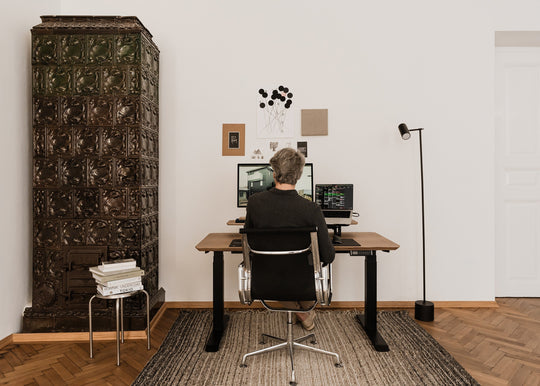
Create a workspace that works for you
One of the biggest upsides of working remotely is being able to design your own place of work. A home office tailored to your personal needs is not only ergonomically and functionally superior but also makes work more enjoyable and comfortable. Here are some useful tips for creating the perfect workspace that works just for you.
Separate personal from professional
If you don’t happen to have a spare room to turn into an office space, it’s very important to create a clear, physical separation between your professional and personal spheres at home. Close off your office nook from your recreational area with an unconventional decorative screen – not only will it divide your space, it will also be an excellent conversation piece. A double-sided bookshelf or a thick, noise muffling curtain will also do the trick.

Quality setup
Sturdy furniture and top-notch equipment are a high-yield investment into your work performance. The quality of your work, your comfort and wellbeing, even your health are impacted by what you use and how you use it.
Ergonomics for office workers
The first step to an ergonomic setup is choosing an appropriate desk and chair. Their height is of utmost importance – it needs to be tailored to your own frame so that your sitting position is natural and healthy. This will decrease the risk of spine problems and other health issues related to incorrect posture and sedentary lifestyle.
Since we’re already on the topic of ergonomics, we should mention that taking regular breaks and frequently changing your position is crucial for physical and mental wellbeing. There are many alternatives for regular office chairs, for example gym balls or saddle stools. If you, however, don’t want to sit for the majority of your day, an adjustable desk is a perfect solution that allows you to change your position from sitting to standing.

Another factor playing a large role in improving your workspace is the correct placement of your laptop or monitor – the top edge of the screen should be just below your eyeline. If your screen is too low and your neck is constantly tilted forward, you should consider a desk shelf or a laptop stand.

Optimal lighting
Inadequate lighting in your place of work has a negative effect on your eyesight. Try positioning your workspace in a place with access to natural light if possible. Besides that, make sure you have plenty of suitable artificial lighting as both too dim and too bright a light tires your eyes.
Lighting that is too weak forces the eye to strain whereas one that is excessively bright often irritates it. Regularly working in an inadequately lit space causes recurrent headaches and depletes concentration. Apart from your light’s intensity, you should also think about its tone which shouldn’t be too cold (above 5000K) or too warm (below 3000K).
Calming greenery
You don’t have to be a crazy plant lady (or guy) to place a few plant pots around your office. Their green color has the power to improve your mood, destress, and make your workstation a charming oasis. Plants have the unique ability to absorb pollution from the atmosphere and improve the air quality in your room – they improve your health, your wellbeing, and your productivity.

Stimulating art
Art is another wellbeing booster to consider while customizing your workspace. According to research conducted at the University of Exeter, people who work surrounded by art are more productive and indicate higher levels of work satisfaction than people who work in boring beige offices. Even better results were demonstrated by those workers who were able to choose and arrange the art pieces themselves.

Photo by Jonny Caspari on Unsplash
Yes, art can sometimes be a distraction, however, it’s not always the bad kind. As it turns out, the occasional diversion from the task at hand to admire a piece of art stimulates imagination and creativity, but also improves memory, increases productivity, enhances problem solving skills, and allows you to return to your work with more energy and focus. Don’t feel like you have to splash out on an original Picasso, Monet, or Rothko, though ;) – art is a broad term which includes more accessible pieces. All that matters is that looking at it brings you real aesthetic joy.









